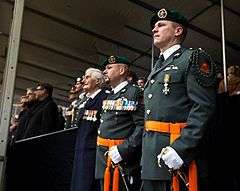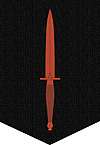Korps Commandotroepen
| Korps Commandotroepen | |
|---|---|
|
Uniform shoulder sleeve insignia of the Korps Commandotroepen (depicting a Fairbairn-Sykes Fighting Knife) | |
| Active | March 22, 1942 - Present |
| Country |
|
| Allegiance | ZM The King |
| Branch | Royal Netherlands Army |
| Type | Special Operations Forces |
| Role |
Direct Action[1] Military Assistance Special Reconnaissance |
| Garrison/HQ | Roosendaal |
| Motto(s) | Nunc aut Nunquam ("Now or Never") |
| Colors | Black with Dark Green Border |
| Insignia | |
| KCT Beret badge |
 |
| Abbreviation | KCT |
The Korps Commandotroepen (KCT) are the special forces of the Royal Netherlands Army. It is one of the three principal units tasked with special operations in the Netherlands (the others being the Maritime Special Operations Forces (NL MARSOF) of the Netherlands Marine Corps and the Brigade Speciale Beveiligingsopdrachten (BSB) of the Royal Marechaussee), and it is deployable anywhere in the world under any circumstance, conducting all conceivable missions from the full spectrum of special operations, including counter-terrorism overseas.
The history of Korps Commandotroepen
.jpg)
World War II
The roots of the KCT go back to World War II. Under the name No.2 (Dutch) Troop, the first Dutch commandos were trained in Achnacarry, Scotland, as part of No. 10 (Inter-Allied) Commando. The unit was formed on March 22, 1942, the birthday of the present KCT. Its purpose was to conduct special operations, which, at the time, were operations that were considered too complex and too dangerous for conventional military personnel. The unit was disbanded in October 1945, but its members continued fighting in the Dutch East Indies, while others formed the Stormschool (1945–1950), located in Bloemendaal. In 1949, the Stormschool relocated itself to the Engelbrecht van Nassaukazerne in Roosendaal, now the home garrison of the present KCT.
Dutch East Indies
Korps Insulinde (1942–1945) was tasked with conducting guerrilla warfare in Sumatra against the Japanese. After the Japanese capitulation, the Korps Insulinde was tasked with the search and rescue of (Dutch) POWs. In November 1945, the unit was disbanded, and its members hooked up with Depot Speciale Troepen and former members of No.2 (Dutch) Troop to form the Regiment Speciale Troepen (1945–1950). This new unit was involved in the Indonesian independence wars after World War II. After Indonesia's independence was acknowledged by the Dutch government in 1949, the RST returned to the Netherlands. On 1 July 1950, on parliamentary recommendation, the RST merged with the Stormschool in Roosendaal to form the present Korps Commandotroepen.
The modern KCT
After the fall of the Berlin Wall in 1989, much changed. Particular events shaped the organisation and capacity of the armed forces, and in particular, that of the KCT. With the threat of Cold War receding, many new conflicts appeared throughout the world. Since the 9/11 Attacks, worldwide terrorism has become the biggest threat, and there has been a very high demand for specialist counter-terrorism units, able to operate overseas. To keep up with these demands, the KCT's old role of Commando Waarnemer-verkenner (Commando Force Reconnaissance) was replaced by that of the modern and versatile Commando Speciale Operaties (co-spec-ops, or Commando Special Operations).
The KCT switched from a "part conscript, part professional force" to a fully professional unit in 1995. The last conscripts made place for professional operators in 1996, when Dutch conscription was suspended. From here, the KCT underwent drastic changes in its structure and operational capability, and with great success. It grew to a mature, professional and versatile SF unit and built up a considerable reputation. Deployments to Bosnia, Kosovo, Macedonia, Iraq and more recently, Afghanistan provided many new insights and knowledge. Successful CT operations in Côte d'Ivoire (2004) and the Middle-East (2006) proved once again that the KCT is an extremely able, highly independent and versatile unit. It consists of four (103, 104, 105 and 108) independent Commando Companies, a staff company and a training company.
KCT operators wear a Commando Green beret. This shade of green is also in use by British Commando Qualified personnel and internationally often worn by other commando units. The brass KCT beret emblem displays a Fairbairn-Sykes Fighting Knife, hand grenade and a ribbon with the unit's Nunc aut Nunquam (now or never) motto on it. The background of the emblem consist of a gothic typeface "W", indicating the name Wilhelmina, Queen of the Netherlands from 1898-1948. The beret emblem is worn on a black background with a green border.
Selection and training
The KCT accepts applications from both actively serving army personnel (infantry) and civilians. To conform to the recruitment guidelines of the Royal Netherlands Army, the KCT accepts both men and women but due to the extreme conditions during the selection, it has been deemed impossible for women to complete the entire trajectory.
Phase zero In order to be considered for the KCT, all civilian and military candidates must participate in a three-day try-out. This try-out is to test each individual's physical and mental stamina, monitored by the KCT cadre and Defense psychologists, who will make a profile of each participant. The try-out's lay-out is kept secret, as a means to see how participants cope with sudden changes and stress. Military candidates additionally require certain military skills such as forced marches, obstacle course and speed march at a set time with medium load.
Phase one Once positively considered, candidates continue to the psychological and medical screening, and if these are met with positive outcomes, they commence with initial training. Civilian candidates will be taken to the AMOL, a 17-week Air Assault school indoctrination with the Luchtmobiele Brigade (Air Assault Brigade), as a means to firmly prepare them with basic military skills and drills. Military candidates will skip this part, and start with the 8-week vooropleiding (VO), the "warm-up" as a preparation for the elementary commando course (ECO), which is the selection. Civilian candidates fresh out of the Air Assault School will join the military candidates here and train together towards 8–9 weeks.
Phase two With an attrition rate of 80-95% for experienced military personnel and 95-100% for civilian candidates, the ECO (elementaire commando opleiding, elementary commando course) serves as the final training phase and selection. Though secretive, one can think of almost continuous physical and mental conditioning. Most of the 8–9 weeks is done outside of Roosendaal, and some parts in the Belgian highlands and mountains. The final week is the culmination exercise, "hell week", which is 5 days of continuous activity including escape and evasion, forced marches and speed marches, coupled with sleep deprivation. It concludes with a final forced march carrying full load to the KCT headquarters. There, the remaining candidates are awarded with the green beret.
Phase three Passing out on the ECO grants temporary right to wear the green beret, and so the prospective operator continues with the vaktechnische opleiding speciale operaties (operator training course). This lasts as much as 12 months and trains the prospective operator in the full spectrum of special operations. The KCT operator is a counter-terrorism specialist, and is also trained as either a medic, a demolitions expert or sniper. New operational team leaders and senior NCOs will be trained as communications specialists. In addition, KCT teams each have a specialisation that is either operating in mountains (above the tree line), underwater or deployment by HAHO/HALO parachute. Each prospective operator will thus receive further training on team level when assigned to his team. By this stage, the operator is granted permanent right to wear the green beret. Eventually the operator will also complete the Counter Terrorism Course (CT).
Tasks

To prepare and to conduct all conceivable missions from the full spectrum of Special Operations such as :
- Long Range Reconnaissance / Intelligence gathering
- Overseas Counter Terrorism
- Offensive operations to protect national and NATO territory
- Peace-Keeping Operations
- Direct Action:
- Neutralization
- Capture
- Sabotage
- Destruction of enemy infrastructure
- Saving civilians and military personnel who are taken hostage
Not specifically belonging to Special Operations but also not unimportant :
- Train indigenous Forces
- Providing support to Main-Forces
- Protection of coalition troops
- Humanitarian Aid
- Combat Search and Rescue
- Non-combatant evacuations
Battle honours

- Arakan 1944
- Nijmegen 1944
- Eindhoven 1944
- Vlissingen 1944
- Westkapelle 1944
- Walcheren 1945
- Djokjakarta 1948
- Central Sumatra 1948-1949
In 2016, the Korps Commandotroepen was awarded the Military Order of William for bravery, leadership and courage during operations in Afghanistan (see below). Peace keeping and peace enforcing operations since 1991:
- Iraq 1991 (Provide Comfort)
- Bosnia-Herzegovina 1994-1995 (United Nations Protection Force)
- Bosnia-Herzegovina 1995-1996 (Implementation Force)
- Bosnia-Herzegovina 1996-1998 (Stabilization Force)
- Bosnia-Herzegovina 1995-2000 (Joint Command Observers)
- Macedonia 2001 (Task Force Harvest)
- Macedonia 2002 (Task Force Fox)
- Afghanistan 2002-2003 (International Security Assistance Force)
- Iraq 2003 (Stabilization Force Iraq)
- Ivory Coast 2004 (Rescue Mission)
- Iraq 2004-2005 (Field Liaison Team)
- Afghanistan 2005-2006 (NLD Special Forces Task Group Orange)(OEF)
- Afghanistan 2006-2007 (NLD Special Forces Task Group Viper) (ISAF)
- Afghanistan 2009-2010 (Special Operation Task Group, TF55) (ISAF)
- Mali May 2014-Today (1(NLD) Special Operations Land Task Group "Scorpion") (MINUSMA)
- Kurdistan 2015-Today (Provide assistance with training and advising alongside NATO against ISIL)
Equipment
Weaponry
| Name | Type | Origin | Chambering | Note |
|---|---|---|---|---|
| Heckler & Koch HK416 | Assault rifle | | 5.56×45mm NATO | D10RS & D14.5RS[2][3][4] |
| Heckler & Koch HK417 | Battle/designated marksman rifle | 7.62×51mm NATO[5][6] | ||
| Heckler & Koch UGL | Grenade launcher | | 40×46mm | |
| Glock 17M | Semi-automatic pistol | | 9×19mm Parabellum | M stands for Maritime springs cups |
| Mossberg 590 | Pump action shotgun | | 12 gauge | |
| FN Minimi | Light machine gun | | 5.56×45mm NATO |
| Name | Type | Origin | Chambering |
|---|---|---|---|
| Accuracy International Arctic Warfare | Sniper rifle | | 7.62×51mm NATO |
| Accuracy International AWSM-F | Sniper rifle | | .338 Lapua Magnum |
| Barrett M82A1 | Anti-materiel rifle | | .50 BMG (12.7×99mm NATO) |
Light weapons/remaining
| Name | Type | Origin | Chambering |
|---|---|---|---|
| FN MAG | General-purpose machine gun | | 7.62×51mm NATO |
| M2 Browning | Heavy machine gun | | .50BMG (12.7×99mm NATO) |
| Heckler & Koch AGW | Automatic Grenade Launcher | | 40×53mm |
| L16 | Mortar | | 81mm |
| M72A2 LAW | Anti-tank rocket launcher | | |
| Panzerfaust 3 | Anti-tank rocket launcher | |
Communication
- AN/PRC-148 Multiband Inter/Intra Team Radio (MBITR) with headset
- AN/PRC-117F Multiband Manpack Radio. It has NSA certification for the transmission of voice and data traffic up to the Top Secret level.
References
- ↑ http://www.korpscommandotroepen.nl/wp-content/uploads/2015/03/Factbook-KCT-2014-English.pdf
- ↑ KCT operator krijgt nieuw persoonlijk wapen, Dutch Defence Press, 16 July 2010 (Dutch)
- ↑ "Special Forces - Wapens - Heckler & Koch 416" (in Dutch). Netherlands Legermuseum: Collectie Informatie Centrum. Retrieved 2010-09-11.
- ↑ HK416 nieuwe wapen commando’s, Dutch Ministry of Defence, 16 July 2010
- ↑ SF Operator worden is een speciaal vak apart, Dutch Defence Press, June 2009
- ↑ "KCT sniper teams are using the Heckler & Koch 417" (in Dutch). Dutch Defence Press. 20 April 2011. Retrieved 2011-06-13.
External links
| Wikimedia Commons has media related to Commando Corps of The Royal Netherlands Army. |
